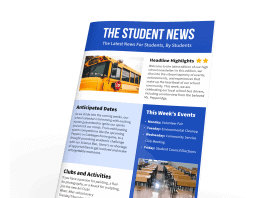Last updated on July 9th, 2024 at 06:33 pm
When it comes to selling properties, first impressions are everything. One of the biggest challenges for any realtor is making their listings stand out in a crowded market. To attract discerning buyers, you need to present each property in the most attractive light possible. One effective way to show off your listings is with real estate marketing brochures.
If you’re a real estate agent, brochures for your available properties can help you step up your game in a big way. Why? A well-designed brochure can make all the difference in capturing potential buyers’ attention and leaving a lasting impression. Featuring beautiful photos and property specifications, potential buyers have everything they need in one place.
Here’s why real estate brochures are so effective, as well as real estate brochure design tips to help you get started.
What is a Real Estate Brochure?
A real estate brochure is a printed marketing tool that showcases a property listing. They usually contain photos of the property, as well as a detailed description of its features. It also includes important information about the property’s location, pricing, and other key details. Brochures are usually printed on thick, glossy paper to make them more attractive.
6 Powerful Benefits of Real Estate Brochures
In addition to a lasting first impression, there are many reasons to use real estate brochures when listing a property for sale. Here are some of the unique benefits of marketing with real estate property brochures.
- Serves as a Powerful Marketing Tool
Real estate pamphlets are an effective way to get the word out about your new property listings. They work as a key component of your comprehensive marketing strategy, getting more prospective buyers in the door while boosting brand visibility. They’re also easy to hand out at in-person events, like open houses or real estate networking groups.
- Facilitates Information Accessibility
A realtor brochure contains all of the important information about your listing in one place. Readers can peruse the property’s specifications and photos all in one compact, easy-to-read document. This makes it easier for them to take action, whether it’s scheduling a viewing or following up to place a bid.
- Showcases Property Highlights
Brochures feature the most attractive parts of your property. If you’re selling a home with a lush backyard, high-tech kitchen, or finished basement, a detailed brochure will show off these features with beautiful photos and descriptions. Buyers want a story about the home, and a well-designed real estate brochure can help craft a compelling narrative that helps them envision their future.
- Increases Brand Visibility
It’s no secret that building a name for yourself in real estate is challenging. Real estate agents can use brochures to boost their overall brand awareness and reputation within the industry. Including your logo, website, and social media handles will put your business front-of-mind for anyone who reads your brochure.
- Encourages Buyer Engagement
After visiting an open house, potential buyers can take a brochure home with them to review. If they’re interested in purchasing the home, they’ll have your contact information readily available. This will encourage them to reach out quickly if they are interested, helping you secure more leads and increase your chances of making a sale
- Generates Increased Interest
Brochures are also an effective way to generate interest in your properties within your community. For example, you can place a box of brochures outside your properties or in high-traffic areas so people can pick them up as they walk by. You can also use direct mail services to distribute these brochures in your area.

What Should a Real Estate Brochure Include?
Your real estate brochure should contain all the information that a potential buyer would need to evaluate the property. The pamphlet should also emphasize the property’s best qualities and provide contact information to encourage buyers.
Here’s a quick checklist of what every real estate brochure should include:
- Property Description – Include accurate descriptions of each property. Mention the general size and layout, the architectural style, the age of the property, and any other pertinent details.
- High-Quality Images – Showcase the beauty of the property with high-quality images of each room and the exterior.
- Floor Plans – Include floor plans to give readers a complete look at the property’s layout. Floor plans should include dimensions for each room.
- Pricing Information – The asking price of the property should be prominently displayed.
- Contact Details – Include a phone number, email address, and any other relevant contact information.
- Location Map – To help readers orient themselves, you can also include a small map of the area with the property clearly marked. For a little extra oomph, you can also add locations of nearby amenities like grocery stores or popular restaurants.
- Key Features and Amenities – Include a list of the property’s most attractive features and amenities early on to catch the reader’s attention.
- Neighborhood Information – Potential buyers will want basic information on the neighborhood, such as the density of buildings, local schools, and proximity to major commercial districts.
- Testimonials or Reviews – Include testimonials from previous clients you’ve worked with to give your brochure more credibility.
- Call to Action – A call to action is a phrase that encourages readers to move forward with the buying process, such as “Reach out today” or “Contact us.” Your call to action should be customized to your property and business.
Tips for Effective Real Estate Brochure Design
Your real estate brochure design will make or break the success of this marketing tool. Here’s how to design a brochure that makes an impact on your audience.
Define Your Target Audience
Before you start writing the copy or putting together the design of your brochure, you’ll need to identify exactly what type of buyer you want to attract. For example, are you looking to attract young first-time buyers, growing families, or retirees? Are you trying to attract real estate investors?
Take the time to understand your target audience and identify their top priorities when purchasing a home. This information should drive your creative decisions when putting together a brochure.
Establish Clear Objectives
You’ll also need to think about your goals for this brochure. Maybe you’re looking to sell the property quickly, or you want to generate media buzz within the community. You might also want to use the brochure as part of a larger marketing campaign. Keep these goals in mind while designing your brochure.
Craft a Compelling Cover Design
The cover of your brochure is the first thing readers will see, so it needs to be eye-catching. Opt for a particularly compelling photo of the property and the address of the property in a sophisticated font. You can also add some small brand assets, such as your logo or business name.
Don’t go overboard with visual elements on the cover, as this can be overwhelming for readers and make the brochure look less professional. Instead, think of the cover as a teaser for the rest of the listing. Look at real estate brochure examples from similar properties in your area for inspiration.
Ensure Consistent Branding
Consistency is key when developing your brochure. Keep colors, fonts, shapes, and other design elements consistent on each page. This makes the entire brochure feel more cohesive. Your brochure’s branding should also be consistent with your other marketing assets, such as your website, social media posts, and advertisements.
Include High-Quality Photos
The quality of your photos can make or break the success of your brochure. Consider hiring a professional photographer to capture your property in the best possible light. Photos should be printed in the best resolution possible so readers can see the property in detail.
Create an Engaging Layout
The interior of your brochure should have a layout that’s captivating but not cluttered. Balance photos with engaging descriptions, lists of key specs, floor plans, and other key elements. If you don’t know where to start with the layout, look for real estate brochure templates to help you get started.
Choose Your Font Carefully
The fonts you select for your brochure make a big impression, so choose wisely. Ideally, you’ll want a font with a balance of personality and clarity. A unique font will help your brochure stand out, but you’ll also need to make sure that your brochure is easy to read. The font should also be the right size for your brochure. It should complement the photos rather than overpowering them.
Be Mindful of White Space
Some white space is necessary in your brochure to provide balance. If you don’t have enough white space, the brochure will feel cluttered and difficult to read. However, too much white space can make the brochure feel empty.
To determine the ideal amount of white space, ensure that text, images, and other elements aren’t positioned too close together. Maintain a clear hierarchy by prioritizing important content and using white space to separate sections, making it easier for readers to digest information.
Highlight Key Selling Points
When potential buyers bring home an open house brochure, they’ll go back and reference it throughout their decision-making process. Highlight key selling points throughout the brochure to make it easy to skim. This will also entice those who haven’t seen the property yet to set up an open house.
Include a Strong Call to Action
Your call to action should use dynamic, engaging language, encouraging potential buyers to take next steps. The call to action should be prominently displayed towards the end of your brochure to keep readers engaged. Additionally, your contact information should be clearly displayed so readers know exactly who to get in touch with.
Use Professional Printing and High-Quality Materials
Using professional printing services will help take your real estate brochure design to the next level. Professional printers use high-quality materials and provide affordable bulk pricing, so you’ll get more bang for your buck than printing on your own. Professional printers can also work with you to bring your brochure ideas to life, helping determine the right type of materials, finish, and more.
Print Your Real Estate Brochure with Printivity
In a world that focuses heavily on digital marketing, a high-quality printed brochure makes your listing more memorable. Brochures give potential buyers something tangible to help them remember each property, and there’s no better place to print yours than Printivity.
With custom printing solutions and lightning-fast turnaround times, our brochure printing services can help you boost your real estate business while helping buyers find their dream homes. Get in touch today!





